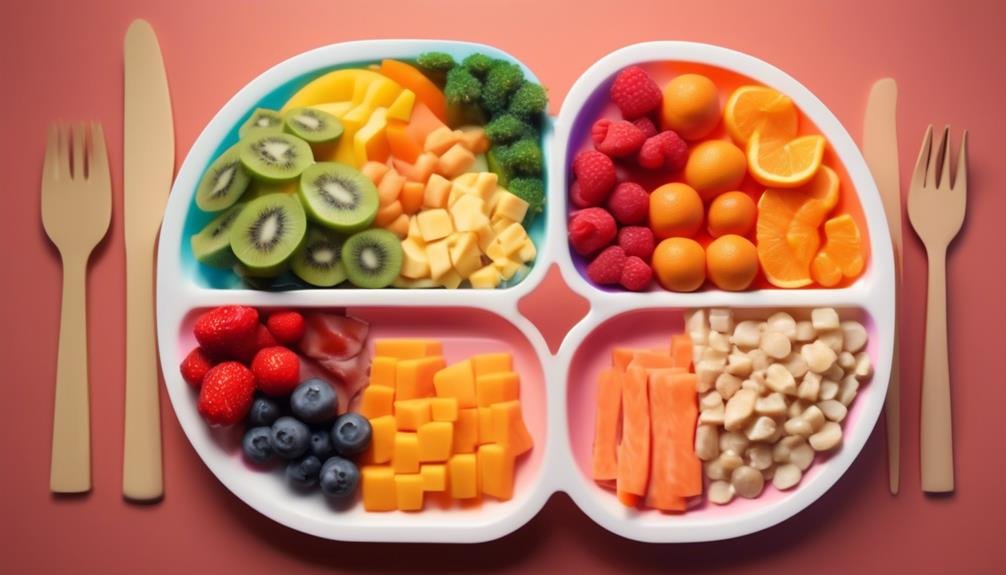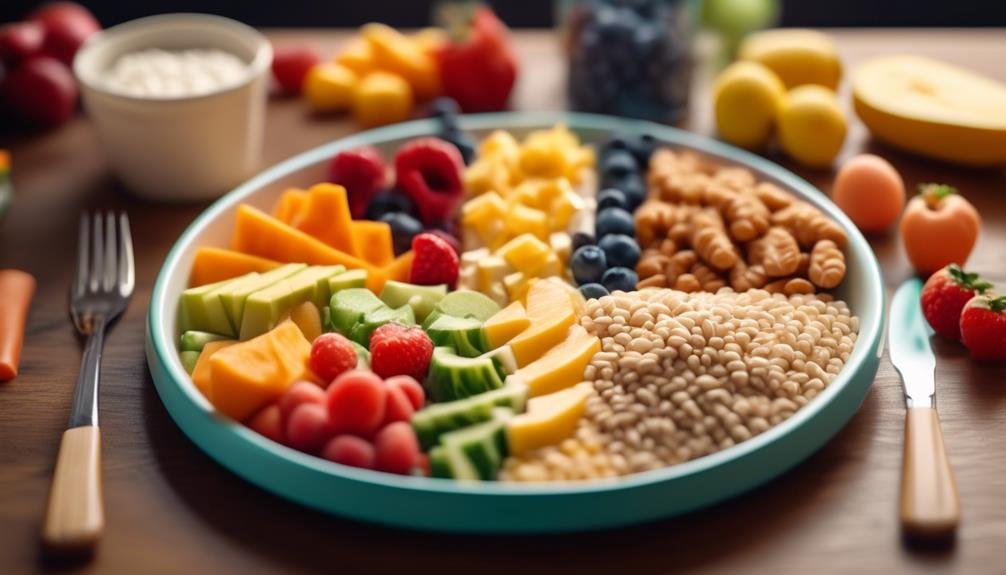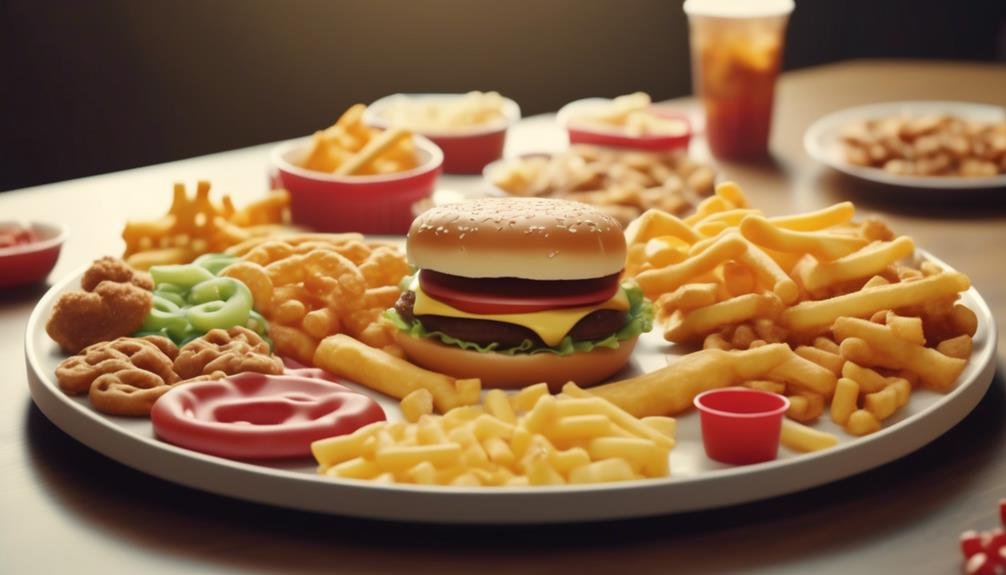Portion Sizes for Kids
Imagine trying to fit a square peg into a round hole – it just doesn't quite fit, does it? Well, when it comes to portion sizes for kids, it's a bit like trying to fit an adult-sized meal into a pint-sized tummy.
But don't fret, there's a solution. In this discussion, we'll explore the importance of understanding portion sizes for kids and delve into factors to consider when determining the right amount of food to serve.
So, sit tight and get ready to discover how you can help your little ones eat just the right amount to keep them healthy and satisfied.
Key Takeaways
- Understanding portion sizes for kids is important for promoting healthy eating habits and ensuring they receive the right amount of nutrients.
- Schools play a crucial role in shaping eating behaviors, and portion sizes in schools should be tailored to meet nutritional needs.
- Factors to consider when determining portion sizes include age, growth stage, activity level, individual metabolism, and dietary restrictions or health conditions.
- Recommended serving sizes for different food groups include 1 cup of fruits and vegetables per day, 1/4 to 1/2 cup of whole grains depending on age and appetite, 1-2 ounces of protein-rich foods for toddlers, and 1/2 to 1 cup of dairy products per day for calcium and vitamin D.
Understanding Portion Sizes for Kids

Understanding portion sizes for kids is essential for promoting healthy eating habits and ensuring they receive the right amount of nutrients. This is particularly important in schools, where children often consume their meals. Schools play a crucial role in shaping children's eating behaviors, and providing appropriate portion sizes is key.
Portion sizes in schools should be tailored to meet the nutritional needs of growing children. The U.S. Department of Agriculture (USDA) provides guidelines for school meals, including recommended portion sizes for different age groups. These guidelines take into account the nutritional requirements of children and aim to provide balanced meals.
For toddlers, portion sizes should be smaller compared to older children. Toddlers have smaller stomachs and appetites, so it's important not to overwhelm them with large portions. Offering smaller, age-appropriate portions can help toddlers develop healthy eating habits and prevent overeating.
To ensure proper portion sizes at school and at home, it's helpful to use visual cues. For example, a serving of vegetables can be represented by a handful or half a cup. This can help children and parents better understand how much they should be eating. Additionally, using smaller plates and bowls can create the illusion of larger portions, which can be helpful for children who may be resistant to trying new foods.
Factors to Consider When Determining Portion Sizes
When determining portion sizes, it's important to consider several factors that can contribute to a child's overall nutritional needs and eating habits. Here are some factors to keep in mind:
- Age and growth stage: As children grow, their nutritional needs change. Younger children require smaller portion sizes compared to older children and teenagers. It's crucial to adjust portion sizes accordingly to meet their changing needs.
- Activity level: Active children typically require more calories to fuel their bodies. If your child participates in sports or engages in regular physical activity, it may be necessary to provide slightly larger portion sizes to ensure they're getting enough energy.
- Individual metabolism: Every child is unique, and their metabolism can vary. Some children naturally have a faster metabolism, meaning they burn calories at a quicker rate. If your child falls into this category, they may need slightly larger portion sizes to meet their energy requirements.
- Dietary restrictions or health conditions: If your child has specific dietary restrictions or health conditions, it's essential to consider these when determining portion sizes. Consulting with a healthcare professional or registered dietitian can help ensure that your child's portion sizes align with their individual needs.
Recommended Serving Sizes for Different Food Groups

To ensure a balanced diet for your child, it's important to understand the recommended serving sizes for different food groups. Understanding portion control is crucial in maintaining your child's health and preventing overeating.
Let's take a closer look at the recommended portion sizes for toddlers.
For fruits and vegetables, aim for about 1 cup of fruits and 1 cup of vegetables per day. This can be spread across different meals and snacks to ensure variety.
Whole grains, such as bread, cereal, and rice, should be served in portions of about 1/4 to 1/2 cup, depending on your child's age and appetite.
When it comes to protein-rich foods like meat, poultry, fish, and legumes, a serving size of about 1-2 ounces is suitable for toddlers.
Dairy products, such as milk, cheese, and yogurt, can be served in portions of 1/2 to 1 cup per day to meet their calcium and vitamin D needs.
How to Measure Portion Sizes for Kids
You can easily measure portion sizes for kids by using simple tools and guidelines. Here are some tips to help you with portion control strategies:
- Use measuring cups: Measuring cups are a great tool to accurately measure dry ingredients like cereal, rice, or pasta. They can also be used for measuring liquids such as milk or juice.
- Use a kitchen scale: A kitchen scale can be helpful when measuring portions of protein, such as meat or fish. Weighing the food can give you a more precise measurement and ensure that your child is getting the right amount.
- Use your hand as a guide: Your hand can be a handy tool for estimating portion sizes. For example, a serving of vegetables should be about the size of your child's fist, while a serving of meat should be about the size of their palm.
- Read food labels: Many packaged foods come with serving size information on the label. Pay attention to these recommended serving sizes and adjust accordingly.
Tips for Encouraging Healthy Portion Sizes

Encourage healthy portion sizes for your child by role modeling and creating a positive food environment. Children often learn by observing their parents, so it's important to set a good example when it comes to portion control strategies. Show them that you prioritize balanced meals by creating a balanced plate for yourself and for them.
To help you with this, here is a simple 3 column and 5 row table that you can follow:
| Protein | Vegetables | Grains |
|---|---|---|
| Lean meat, poultry, fish | Broccoli, carrots, spinach | Whole wheat bread, brown rice |
| Eggs | Bell peppers, peas, corn | Quinoa, whole wheat pasta |
| Beans, lentils | Tomatoes, cucumbers, zucchini | Oats, whole grain cereal |
By including a variety of foods from each column in your child's meals, you can create a balanced plate that provides the necessary nutrients. Additionally, here are some practical tips to encourage healthy portion sizes:
- Serve smaller portions and allow your child to ask for more if they are still hungry.
- Use smaller plates and bowls to visually make portions look larger.
- Limit sugary drinks and encourage water instead.
- Encourage your child to eat slowly and listen to their body's hunger and fullness cues.
- Involve your child in meal planning and preparation to increase their interest in healthy eating.
The Role of Parents in Teaching Portion Control
Parents play a crucial role in teaching their children about portion control and fostering healthy eating habits. By providing guidance and setting an example, parents can help their children develop a positive relationship with food and learn to make mindful choices. Here are some ways parents can effectively teach portion control:
- Be a role model: Children learn by observing their parents, so it's important to demonstrate healthy portion sizes and balanced eating habits. Show them how to listen to their bodies and stop eating when they feel satisfied.
- Involve children in meal planning and preparation: When children participate in planning and cooking meals, they become more aware of portion sizes and the nutritional content of different foods. This can encourage them to make healthier choices and be more mindful of their portions.
- Teach portion sizes visually: Use visual cues to help children understand appropriate portion sizes. For example, you can use everyday objects like a baseball or a deck of cards to demonstrate the right amount of food for different food groups.
- Encourage self-regulation: Teach children to listen to their bodies and recognize hunger and fullness cues. Encourage them to eat slowly and savor their food, allowing their bodies to signal when they're satisfied.
Common Pitfalls to Avoid When Serving Kids' Portions

What are some common pitfalls to avoid when serving portions to kids? When it comes to portion sizes for kids, there are several challenges that parents often face. It can be difficult to determine the right amount of food to serve, especially when children have varying appetites and nutritional needs. To help you navigate this issue, here are some common pitfalls to avoid and portion control strategies to implement:
| Pitfall | Description | Portion Control Strategy |
|---|---|---|
| Serving adult-sized portions | Giving children the same amount of food as adults can lead to overeating and weight gain. | Use smaller plates and bowls to create the illusion of a full plate. |
| Allowing self-serving | Allowing children to serve themselves can result in oversized portions and excessive calorie consumption. | Pre-portion meals and snacks, and teach children to listen to their hunger and fullness cues. |
| Using food as a reward or punishment | Using food as a reward or punishment can create an unhealthy relationship with food and lead to emotional eating. | Find non-food rewards and punishments, such as extra playtime or loss of privileges. |
| Giving in to food preferences | Catering to children's food preferences can limit their exposure to new foods and lead to imbalanced nutrition. | Offer a variety of healthy options at each meal and encourage trying new foods. |
Adjusting Portion Sizes for Picky Eaters and Active Children
When it comes to adjusting portion sizes for picky eaters and active children, it's important to consider their individual needs and preferences. Here are some practical tips to help you navigate this challenge:
- Communicate with your child: Talk to your child about their food preferences and involve them in meal planning. This will help you understand their likes and dislikes, allowing you to adjust portion sizes accordingly.
- Offer a variety of options: Picky eaters often have a limited range of foods they enjoy. To ensure they receive adequate nutrition, offer a variety of healthy options within their preferred food groups. This will help them meet their nutritional needs while still accommodating their tastes.
- Consider texture and presentation: Picky eaters may be more likely to try new foods if they're presented in an appealing way. Experiment with different textures, colors, and shapes to make meals more enticing.
- Adjust portion sizes for active children: Active children require more energy to fuel their physical activity. Consider increasing their portion sizes of carbohydrates and protein, such as whole grains, lean meats, and dairy products. This will help support their growth, development, and overall health.
Frequently Asked Questions
Can I Use the Same Portion Sizes for My Picky Eater as I Would for My Active Child?
You should consider using different portion sizes for your picky eater compared to your active child. Picky eaters may need smaller portions to avoid overwhelming them, while active children may require more food to fuel their energy levels.
What Are Some Common Mistakes Parents Make When Serving Portion Sizes for Kids?
When serving portion sizes for kids, parents often make mistakes that can affect their child's health. Challenges like unrealistic expectations and using adult-sized portions can lead to overeating or picky eating habits.
How Can I Measure Portion Sizes Without Using a Scale or Measuring Cups?
To measure portion sizes without a scale or measuring cups, try using your hand as a guide. For example, a serving of protein should be about the size of your palm. These portion control tricks can help parents ensure their kids are eating the right amount.
Are There Any Factors That Influence Portion Sizes for Kids Other Than Their Age?
When it comes to portion sizes for kids, there are more factors at play than just age. Factors like activity level, growth spurts, and taste preferences can all influence how much they should eat. Variety is also important to ensure they get the nutrients they need.
Can You Provide Some Tips for Encouraging Kids to Eat Healthy Portion Sizes Without Making Them Feel Restricted?
Encouraging healthy eating habits in kids can be done by balancing portion sizes. Offer a variety of nutritious foods, involve them in meal planning, and make mealtimes enjoyable. Remember, it's important to avoid making them feel restricted.
Conclusion
In conclusion, when it comes to portion sizes for kids, it's important to strike a balance. Remember, a child's serving size may differ based on their age, activity level, and specific dietary needs.
By measuring and monitoring portion sizes, parents can empower their children to make healthy eating choices. It's like giving them the keys to a nutritious future, where they can grow and thrive.
So let's serve up the right portions and set our little ones on the path to lifelong well-being.







